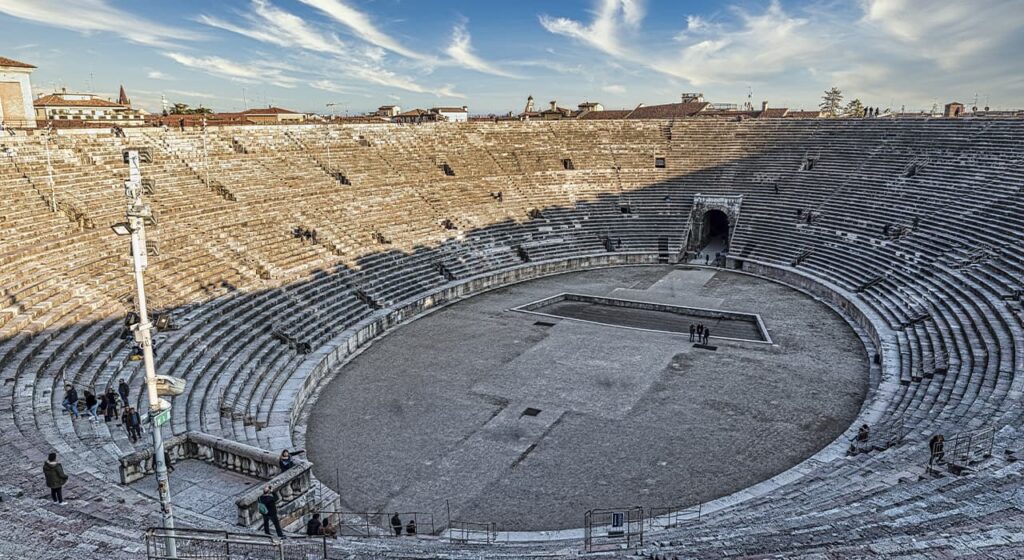
Type of theater auditorium
Following the model of the closed ancient theater, the first European theaters were built, which appeared in Italy during the Renaissance, like the Teatro Olimpico in Vicenza (architect Palladio, 1580). They developed from palace – open theaters with an amphitheater on an earthen hill in the parks of palaces and villas. The auditorium of the Renaissance theater was semicircular or elliptical in shape and consisted of an amphitheater that rose in arched horseshoe ledges upwards from the stage and ended in a semicircular antique colonnade. The spectators of the Olimpico Theater were located not only in the amphitheater, but also in the orchestra.
The amphitheater was preserved even with the appearance in the 17th century. a new type of tiered (rank) theater designed for staging opera performances. The opera demanded good acoustics, optics and a larger capacity from the auditorium. This task was performed by tiers of hinged balconies, they increased the number of seats for the audience at the same area of the hall and served as a sound resonator. In the rank theater, the seats began to be divided into stalls (in which the audience originally stood), an amphitheater and a balcony from a number of tiers, later divided by partitions into boxes (Italian type of theater) or in the form of continuous galleries (French type). The last tier of the theatrical balcony differed from the previous ones in that it was an amphitheater, divided by longitudinal and transverse aisles. So there were places for the unprivileged public, colloquially, the so-called. gallery. This type of theater gained worldwide distribution (Milan’s La Scala, 1776, London’s Covent Garden, 1732, the building of the Paris Opera, 1861-1875).With the differentiation of theatrical genres into musical and dramatic ones, a German, or sectoral, more democratic type of theater hall appeared. The hall of the First Drama Theater in Berlin, 1765, one of the first European drama theaters, was rectangular, had no balconies and consisted of one amphitheater. Due to the small capacity (800 people), this type of theater was not widely used. In 1821, the architects of the Berlin New Drama Theater K.F. Schinkel and G. Semper tried to reform the rank theater and return to the ancient form of the theater. The auditorium with a shallow stage and a wide proscenium consisted of a small semicircular parterre and an antique amphitheater with radial passages, ending with an antique colonnade. Such a hall provided all spectators with equal opportunities to see and hear. In 1913, the Berlin Bolshoi Drama Theater with an open stage was built according to the same type (architect H. Pelzig).
The French architect K.N. Ledoux, the founder of the Empire style, tried to return to the type of the ancient theater when designing the theater in Besançon. He moved away from the type of tiered theater, replacing the traditional tiers and boxes with semicircular amphitheater benches, and for the first time placing chairs in the stalls. True, the Ledoux project was an episode in the history of French theatrical architecture, the apogee of which was the magnificent pseudo-Baroque building of the Paris Opera (architect J. Garnier, 1861-1875).In Russia, since the era of Peter the Great’s reforms, a tiered type of theater has developed, predominantly Italian (the largest domestic theaters: the Alexandrinsky in St. Petersburg, the Bolshoi and Maly in Moscow, the Odessa Opera and Ballet Theater, etc.). In home fortress theaters of the 18th century. both the French type of tiered theater (Kuskovo) and the Italian type (Arkhangelskoye) developed. The view of the open palace theater is represented by an amphitheater in Pavlovsk, 1793. In Russia, a hall in the form of an ancient amphitheater has been preserved only in the Hermitage Theater of the old Winter Palace (architect J. Quarenghi, 1784).
At the beginning of the 20th century in Europe, the types of amphitheater or auditorium (an amphitheater with 1-2 tiers of balconies) halls revived. The attempts to reform the theater hall are connected with the evolution of the stage. With the advent of the tiered theater, a deep stage-box appeared, later there were attempts to make it either flat, as in the ancient theater, or with a proscenium leading into the auditorium, or the stage was completely abandoned and the action was transferred to the auditorium (the project of the functionalist architecture leader V. Groppius and director E. Piscator, Germany, 1920s). In the second half of the 20th century theater halls are being built with a stage surrounded by an amphitheater on four sides (Arena Stage in Washington, 1961), with an annular stage and a rotating amphitheater (Theater at Versailles, 1960).